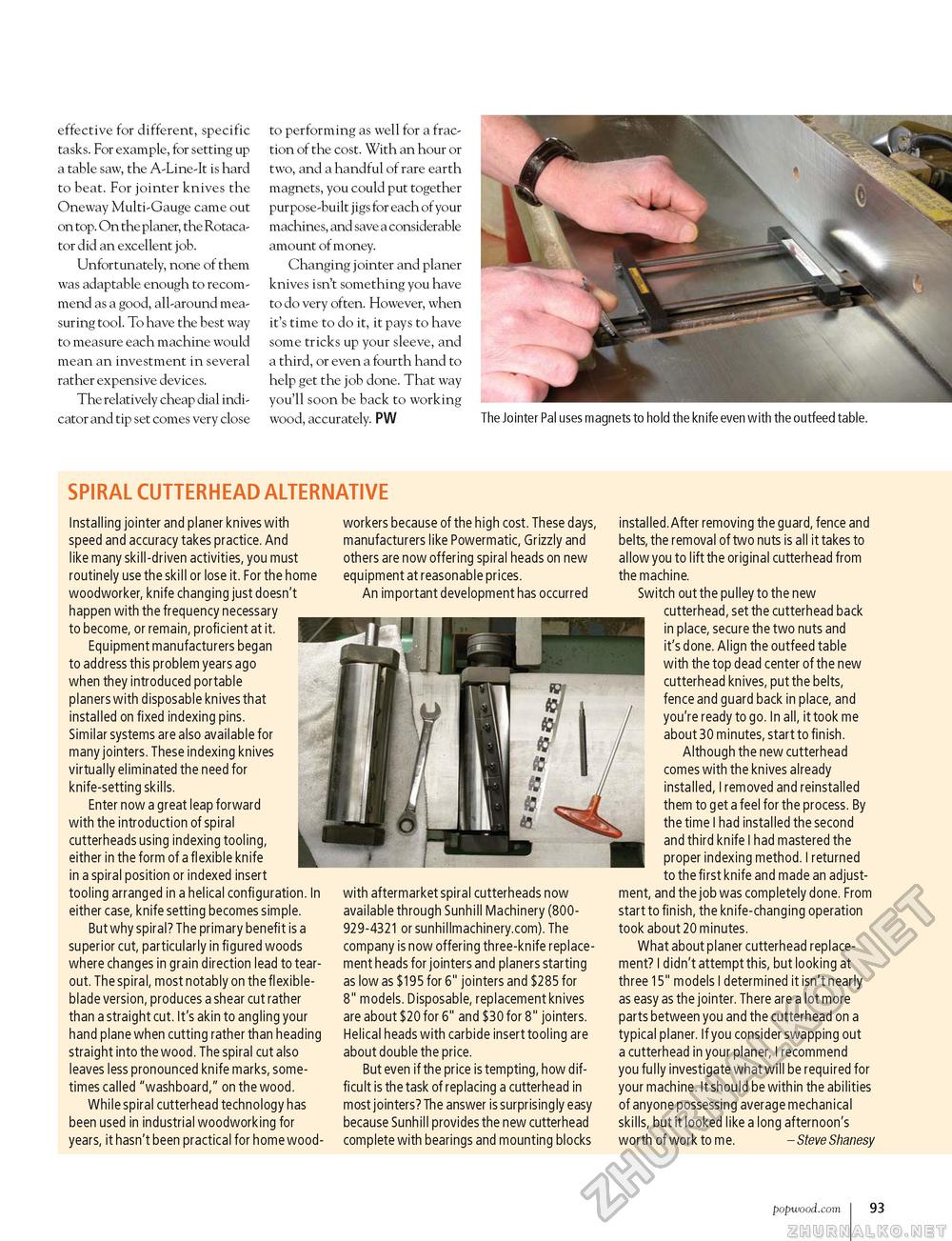Popular Woodworking 2005-10 № 150, страница 97
effective for different, specific tasks. For example, for setting up a table saw, the A-Line-It is hard to beat. For jointer knives the Oneway Multi-Gauge came out on top. On the planer, the Rotaca-tor did an excellent job. Unfortunately, none of them was adaptable enough to recommend as a good, all-around measuring tool. To have the best way to measure each machine would mean an investment in several rather expensive devices. The relatively cheap dial indicator and tip set comes very close to performing as well for a fraction of the cost. With an hour or two, and a handful of rare earth magnets, you could put together purpose-built jigs for each of your machines, and save a considerable amount of money. Changing jointer and planer knives isn't something you have to do very often. However, when it's time to do it, it pays to have some tricks up your sleeve, and a third, or even a fourth hand to help get the job done. That way you'll soon be back to working wood, accurately. PW The Jointer Pal uses magnets to hold the knife even with the outfeed table. SPIRAL CUTTERHEAD ALTERNATIVE Installing jointer and planer knives with speed and accuracy takes practice. And like many skill-driven activities, you must routinely use the skill or lose it. For the home woodworker, knife changing just doesn't happen with the frequency necessary to become, or remain, proficient at it. Equipment manufacturers began to address this problem years ago when they introduced portable planers with disposable knives that installed on fixed indexing pins. Similar systems are also available for many jointers. These indexing knives virtually eliminated the need for knife-setting skills. Enter now a great leap forward with the introduction of spiral cutterheads using indexing tooling, either in the form of a flexible knife in a spiral position or indexed insert tooling arranged in a helical configuration. In either case, knife setting becomes simple. But why spiral? The primary benefit is a superior cut, particularly in figured woods where changes in grain direction lead to tear-out. The spiral, most notably on the flexible-blade version, produces a shear cut rather than a straight cut. It's akin to angling your hand plane when cutting rather than heading straight into the wood. The spiral cut also leaves less pronounced knife marks, sometimes called "washboard," on the wood. While spiral cutterhead technology has been used in industrial woodworking for years, it hasn't been practical for home wood workers because of the high cost. These days, manufacturers like Powermatic, Grizzly and others are now offering spiral heads on new equipment at reasonable prices. An important development has occurred with aftermarket spiral cutterheads now available through Sunhill Machinery (800929-4321 or sunhillmachinery.com). The company is now offering three-knife replacement heads for jointers and planers starting as low as $195 for 6" jointers and $285 for 8" models. Disposable, replacement knives are about $20 for 6" and $30 for 8" jointers. Helical heads with carbide insert tooling are about double the price. But even if the price is tempting, how difficult is the task of replacing a cutterhead in most jointers? The answer is surprisingly easy because Sunhill provides the new cutterhead complete with bearings and mounting blocks installed. After removing the guard, fence and belts, the removal of two nuts is all it takes to allow you to lift the original cutterhead from the machine. Switch out the pulley to the new cutterhead, set the cutterhead back in place, secure the two nuts and it's done. Align the outfeed table with the top dead center of the new cutterhead knives, put the belts, fence and guard back in place, and you're ready to go. In all, it took me about 30 minutes, start to finish. Although the new cutterhead comes with the knives already installed, I removed and reinstalled them to get a feel for the process. By the time I had installed the second and third knife I had mastered the proper indexing method. I returned to the first knife and made an adjustment, and the job was completely done. From start to finish, the knife-changing operation took about 20 minutes. What about planer cutterhead replacement? I didn't attempt this, but looking at three 15" models I determined it isn't nearly as easy as the jointer. There are a lot more parts between you and the cutterhead on a typical planer. If you consider swapping out a cutterhead in your planer, I recommend you fully investigate what will be required for your machine. It should be within the abilities of anyone possessing average mechanical skills, but it looked like a long afternoon's worth of work to me. - Steve Shanesy popwood.com i 93 |








